The Geochemical Characteristics of Trace Elements in the Magnetite and Fe Isotope Geochemistry of the Makeng Iron Deposit in Southwest Fujian and Their Significance in Ore Genesis
Abstract
:1. Introduction
2. Geological Background
3. Geological Characteristics of Deposit

4. Sample Collection and Analyses
4.1. Magnetite Trace Element Analysis
4.2. Fe Isotope Analysis
5. Results
5.1. Magnetite Trace Element Composition
5.2. Fe Isotopic Concentration
6. Discussion
6.1. Constraint of Magnetite Trace Element Composition on Deposit Genesis
6.2. Fe Isotopic Composition and Fe Source
6.3. Evolution of Mineralization Fluid and Constraints of Mineralization Process
7. Conclusions
- (1)
- The magnetite in the Makeng iron deposit exhibits significantly lower concentrations of V, Ti, Cu, and Zn and higher levels of Si than magnetite sourced from volcanic or marine volcanic sedimentary origins. It is evident that the Makeng magnetite is closely linked to skarn genesis.
- (2)
- The δ57Fe values in magnetite range from −0.091‰ to 0.317‰. The Makeng iron deposit has multiple Fe sources, with Yanshanian granitic intrusions likely being the primary contributor. There might also be contributions from mantle-derived diabase, and a potential role of Lindi Formation sandstone as a source of Fe for mineralization cannot be ruled out.
- (3)
- The Makeng iron deposit is a skarn deposit closely linked to Yanshanian granitic intrusions. Initially, the ore-forming fluid was a high-temperature, high-oxygen fugacity magmatic hydrothermal solution. Over time, it transitioned into a hydrothermal solution with lower temperatures and reducing conditions. Magnetite formation occurred primarily during the calcareous skarnization stage, extending into the early part of the retrograde metasomatic stage. Additionally, sulfides like molybdenite, pyrite, chalcopyrite, sphalerite, and galena were generated during the quartz–sulfide stage.
Supplementary Materials
Author Contributions
Funding
Data Availability Statement
Conflicts of Interest
References
- Chen, Y.S. A New Understanding on Genesis of Ore Deposits During the Development of Makeng iron deposit. Met. Mine 2002, 317, 50–59. [Google Scholar]
- Wang, W.B.; Wang, R.H.; Ji, S.X.; Xing, W.C. The Origin of Iron Ores of the Makeng type in Southwestern Fujian as Viewed in the light of Certain Characteristics of the Magnetite. Geol. Rev. 1982, 28, 119–125. [Google Scholar]
- Liu, J.H. A Genetic Mineralogical Study of Magnetite in the Makeng iron deposit, Fujian Province. Miner. Rocks. 1989, 9, 26–39. [Google Scholar]
- Mao, J.R.; Tao, K.Y.; Xie, F.G.; Xu, N.Z.; Chen, S.Y. Rock-Forming and Ore-Forming Processes and Tectonic Environments in Southwest Fujian. Acta Petrol. Mineral. 2001, 20, 329–336. [Google Scholar]
- Zhao, Y.M.; Tan, H.J.; Yuan, R.G.; Lin, F.X. Discovery of the chlor-amphibole from some skarn-type iron deposits in southwestern Fujian and its geological significance. Geol. Rev. 1980, 26, 300–306. [Google Scholar]
- Zhang, C.S. Geology and Geochemistry of Makeng iron deposit in Fujian. Ph.D. Thesis, China University of Geosciences, Beijing, China, 2012. [Google Scholar]
- Zhang, Z.J.; Zuo, R.G.; Cheng, Q.M. Geological Features and Formation Processes of Makeng Fe Deposit, China. Resour. Geol. 2015, 65, 266–284. [Google Scholar] [CrossRef]
- Zuo, R.G.; Zhang, Z.J.; Zhang, D.J.; Carranza, E.J.; Wang, H.C. Evaluation of Uncertainty in Mineral Prospectivity Mapping Due to Missing Evidence: A Case Study with Skarn-Type Fe Deposits in Sourthwestern Fujian Province, China. Ore Geol. Rev. 2015, 71, 502–525. [Google Scholar] [CrossRef]
- Zhang, Z.J.; Zuo, R.G. Sr-Nd-Pb isotope Systematics of Magnetite: Implications for the Genesis of Makeng Fe Deposit, Southern China. Ore Geol. Rev. 2014, 57, 53–60. [Google Scholar] [CrossRef]
- Yang, Y.L.; Ni, P.; Pan, J.Y.; Wang, G.G.; Xu, Y.F. Constraints on the Mineralization Processes of Makeng iron deposit, Eastern China: Fluid Inclusion, H-O Isotope and Magnetite Trace Element Analysis. Ore Geol. Rev. 2017, 88, 791–808. [Google Scholar] [CrossRef]
- Lin, D.Y. Research on Late Paleozoic-Triassic Tectonic Evolution and Iron Polymetallic Deposit Mineralization Laws in Southwest Fujian. Ph.D. Thesis, China University of Geosciences, Beijing, China, 2011. [Google Scholar]
- Zhang, D.; Wu, G.G.; Di, Y.J.; Lv, L.J.; Yao, J.M. Evolution of tectonic stress field in southwestern Wuyishan Mountain area and relationship with mineralization. Geol. Bull. China 2011, 30, 505–513. [Google Scholar]
- Wang, S. Research on Mineralization Elements and Prospecting Prediction of Makeng iron deposit in Southwest Fujian. Ph.D. Thesis, China University of Geosciences, Beijing, China, 2016. [Google Scholar]
- Mao, J.R.; Chen, R.; Li, J.Y.; Ye, H.M.; Zhao, X.L. Geochronology and geochemical characteristics of late Mesozoic granotic rocks from southwestern Fujian and their tectonic evolution. Acta Petrol. Sin. 2006, 22, 1723–1734. [Google Scholar]
- Zhang, C.S.; Su, H.M.; Yu, M.; Hu, Z.G. Zircon U-Pb age and Nd-Sr-Pb isotopic characteristics of Dayang-Juzhou granite in Longyan, Fujian Province and its geological significance. Acta Petrol. Sin. 2012, 28, 225–242. [Google Scholar]
- Zhang, Z.J.; Zuo, R.G.; Cheng, Q.M. The Mineralization Age of the Makeng Fe Deposit, South China: Implications from U-Pb and Sm-Nd Geochronology. Int. J. Earth Sci. 2015, 104, 663–682. [Google Scholar] [CrossRef]
- Zheng, M.Q.; Zhang, D.; Huang, C.H. Special Mapping and Technical Application Demonstration Report on Integrated Exploration Area of Longyan Makeng-Datian Tangquan Iron Deposits in Fujian (Achievement Report); Fujian Institute of Geological Survey: Fuzhou, China, 2016. [Google Scholar]
- Yi, J.J. Study on Genesis Mechanism and Prospecting Model of Makeng iron deposit in Southwest Fujian. Ph.D. Thesis, China University of Geosciences, Beijing, China, 2018. [Google Scholar]
- The 8th Geological Brigade of Fujian. Geological Characteristics and Genesis of Makeng Iron Deposit in Longyan, Fujian Province. Geology of Fujian 1982, 2–31. [Google Scholar]
- Zhang, Z.; Zhang, C.S. Skarn mineral characteristics and zonation of the Makeng Fe-Mo deposit in Fujian Province. Acta Petrol. Sin. 2014, 30, 1339–1354. [Google Scholar]
- Longerich, H.P.; Jackson, S.E.; Günther, D. Inter-laboratory note. Laser Ablation Inductively Coupled Plasma Mass Spectrometric Transient Signal Data Acquisition and Analyte Concentration Calculation. J. Anal. At. Spectrom. 1996, 11, 899–904. [Google Scholar] [CrossRef]
- Zhang, Z.J.; Zuo, R.G. Iron Isotope Systematics of Magnetite: Implications for the Genesis of Makeng iron deposit, Southern China. Acta Geol. Sin. (Engl. Ed.) 2013, 87, 840–843. [Google Scholar]
- Johnson, C.M.; Beard, B.L.; Roden, E.E. Isotopic Constraints on Biogeochemical Cycling of Fe. Rev. Mineral. Geochem. 2004, 55, 359–408. [Google Scholar] [CrossRef]
- Wang, Y.; Zhu, X.K. Fe isotope systematics and its implications in ore deposit geology. Acta Petrol. Sin. 2012, 28, 3638–3654. [Google Scholar]
- He, Y.S.; Ke, S.; Teng, F.Z.; Wang, T.T.; Wu, H.J.; Lu, Y.H.; Li, S.G. High-Precision Iron Isotope Analysis of Geological Reference Materials by High-Resolution MC-ICP-MS. Geostand. Geoanalytical Res. 2015, 39, 341–356. [Google Scholar] [CrossRef]
- Rudnick, R.L.; Gao, S. Composition of the Continental Crust. In Treatise on Geochemistry, Volume 3: The Crust; Rudnick, R.L., Ed.; Elsevier-Pergamon: Oxford, UK, 2003; pp. 1–64. [Google Scholar]
- Zhao, X.M.; Zhu, X.K.; Zhang, H.F.; Tang, S.H. Applications of Fe isotopes to tracing mantle processes. Acta Petrol. Mineral. 2008, 27, 435–440. [Google Scholar]
- Fantle, M.S.; Depaolo, D.J. Iron isotopic Fractionation During Continental Weathering. Earth Planet. Sci. Lett. 2004, 228, 547–562. [Google Scholar] [CrossRef]
- Rouxel, O.J.; Bekker, A.; Edwards, K.J. Iron Isotope Constraints on the Archean and Paleoproterozoic Ocean Redox State. Science 2005, 307, 1088–1091. [Google Scholar] [CrossRef]
- Nadoll, P. Geochemistry of Magnetite from Hydrothermal Ore Deposits and Host Rocks: Case Studies from the Proterozoic Belt Supergroup, Cu-Mo-Porphyry + Skarn and Climax-Mo Deposits in the Western United States. Ph.D. Thesis, University of Auckland, Auckland, New Zealand, 2009. [Google Scholar]
- Xu, G.F.; Shao, J.L. Typomorphic Characteristics and Practical Significance of Magnetite. Geol. Explor. 1979, 23, 30–37. [Google Scholar]
- Shimazaki, H. On the Occurrence of Silician Magnetites. Resour. Geol. 1998, 48, 23–29. [Google Scholar] [CrossRef]
- Lin, S.Z. Discussion on Mineral Chemistry, Genesis and Evolution of Magnetite. J. Miner. 1982, 2, 166–174. [Google Scholar]
- Singoyi, B.; Danyushevsky, L.; Davidson, G.J.; Large, R.; Zaw, K. Determination of Trace Elements in Magnetites from Hydrothermal Deposits Using the LA ICP-MS Technique. In Proceedings of the SEG Keystone Conference, Dever, CA, USA, 14 May 2006. [Google Scholar]
- Dupuis, C.; Beaudoin, G. Discriminant Diagrams for Iron Oxide trace Element Fingerprinting of Mineral Deposit Types. Miner. Depos. 2011, 46, 319–335. [Google Scholar] [CrossRef]
- Nadoll, P.; Angerer, T.; Mauk, J.L.; French, D.; Walshe, J. The Chemistry of Hydrothermal Magnetite: A Review. Ore Geol. Rev. 2014, 61, 1–32. [Google Scholar] [CrossRef]
- Hu, H.; Lentz, D.; Li, J.W.; Mccarron, T.; Zhao, X.F.; Hall, D. Re-Equilibration Processes of Magnetite from Iron Skarn Deposits. Econ. Geol. 2015, 110, 1–8. [Google Scholar] [CrossRef]
- Li, H.Z.; Zhai, M.G.; Zhang, L.C.; Li, Z.Q.; Zheng, M.T.; Niu, J.; Yu, P.P. Study on Geochemistry and Micro-Area Characteristics of Paleoproterozoic Chemical Sedimentary Rocks from Zankan Area, West Kunlun, China. Acta Petrol. Sin. 2016, 32, 233–250. [Google Scholar]
- Zhu, X.K.; Sun, J.; Wang, Y. Fe Isotope Geochemistry of Magmatic System. J. Earth Sci. Environ. 2016, 38, 1–10. [Google Scholar]
- Zhang, Z.J. Research on Genesis & Quantitative Prediction and Evaluation of Makeng Type Iron Ore Deposits in Southwest Fujian. Ph.D. Thesis, China University of Geosciences, Wuhan, China, 2015. [Google Scholar]
- Zhao, Y.M.; Tan, H.J.; Xu, Z.N.; Yuan, R.G.; Bi, C.S.; Zheng, R.L.; Li, D.X.; Sun, J.H. The Makeng Calcium Skarn Type Iron Deposits in the Southwest of Fujian; Bulletin of the Insitute of Mineral Resources, Chinese Academy of Geological Sciences; Geological Publishing House: Beijing, China, 1983. [Google Scholar]
- Wang, S.; Zhang, D.; Wu, G.G.; Yi, J.J.; Li, X.J.; Yu, T.D.; Bai, Y.; Gao, X.Q. Metallogenic structctural plane characteristics and it’s prospecting importance for the Makeng type iron deposits in southwestern Fujian province. J. Geomech. 2018, 24, 199–211. [Google Scholar]
- Meinert, L.D. Application of skarn deposit zonation models to mineral exploration. Explor. Min. Geol. 1997, 6, 185–208. [Google Scholar]
- Einaudi, M.T.; Meinert, L.D.; Newberry, R.J. Skarn deposits. Econ. Geol. 1981, 75, 317–391. [Google Scholar]
- Einaudi, M.T.; Burt, D.M. Introduction-terminology, classification and composition of skarn deposits. Econ. Geol. 1982, 77, 745–754. [Google Scholar] [CrossRef]
- Chen, Y.; Zhang, Z.C. Study on Source, Transport and the Enrichment Mechanism of Iron in Iron Skarn Deposits. Rock Miner. Anal. 2012, 31, 889–897. [Google Scholar]
- Dare, S.; Barnes, S.J.; Beaudoin, G.; Méric, J.; Boutroy, E.; Potvin-Doucet, C. Trace Elements in Magnetite as Petrogenetic Indicators. Miner. Depos. 2014, 49, 785–796. [Google Scholar] [CrossRef]
- Hu, H.; Li, J.W.; Lentz, D.; Ren, Z.; Zhao, X.F.; Deng, X.D.; Hall, D. Dissolution-reprecipitation Process of Magnetite from the Chengchao Iron Deposit: Insights into Ore Genesis and Implication for In-Situ Chemical Analysis of Magnetite. Ore Geol. Rev. 2014, 57, 393–405. [Google Scholar] [CrossRef]
- Li, W.; Xie, G.Q.; Zhu, Q.Q.; Zheng, X.W.; Zhang, Z.Y.; Han, Y.X. Multi-superimposed mineralization process in Chengchao iron deposit, southeastern Hubei Province: Evidence from the study of magnetite. Acta Petrol. Sin. 2016, 32, 471–492. [Google Scholar]
- Yi, J.J.; Zhang, D.; Ji, G.Y.; Wang, N.; Wang, S. REE Geochemistry and its Implication on Genesis of the Makeng iron deposit in Southwestern Fujian Province, China. Geotecton. Metallog. 2021, 45, 705–726. [Google Scholar]
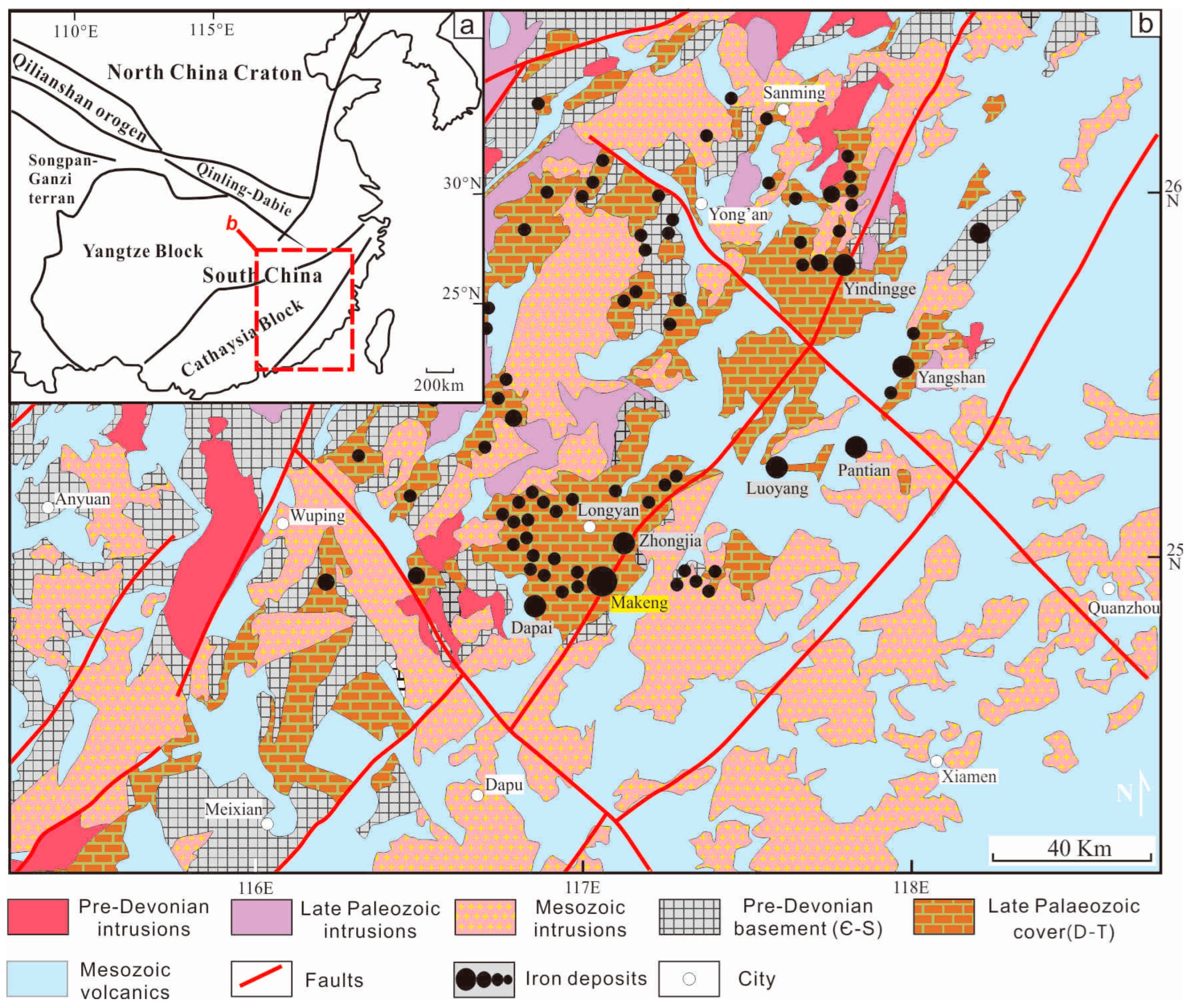

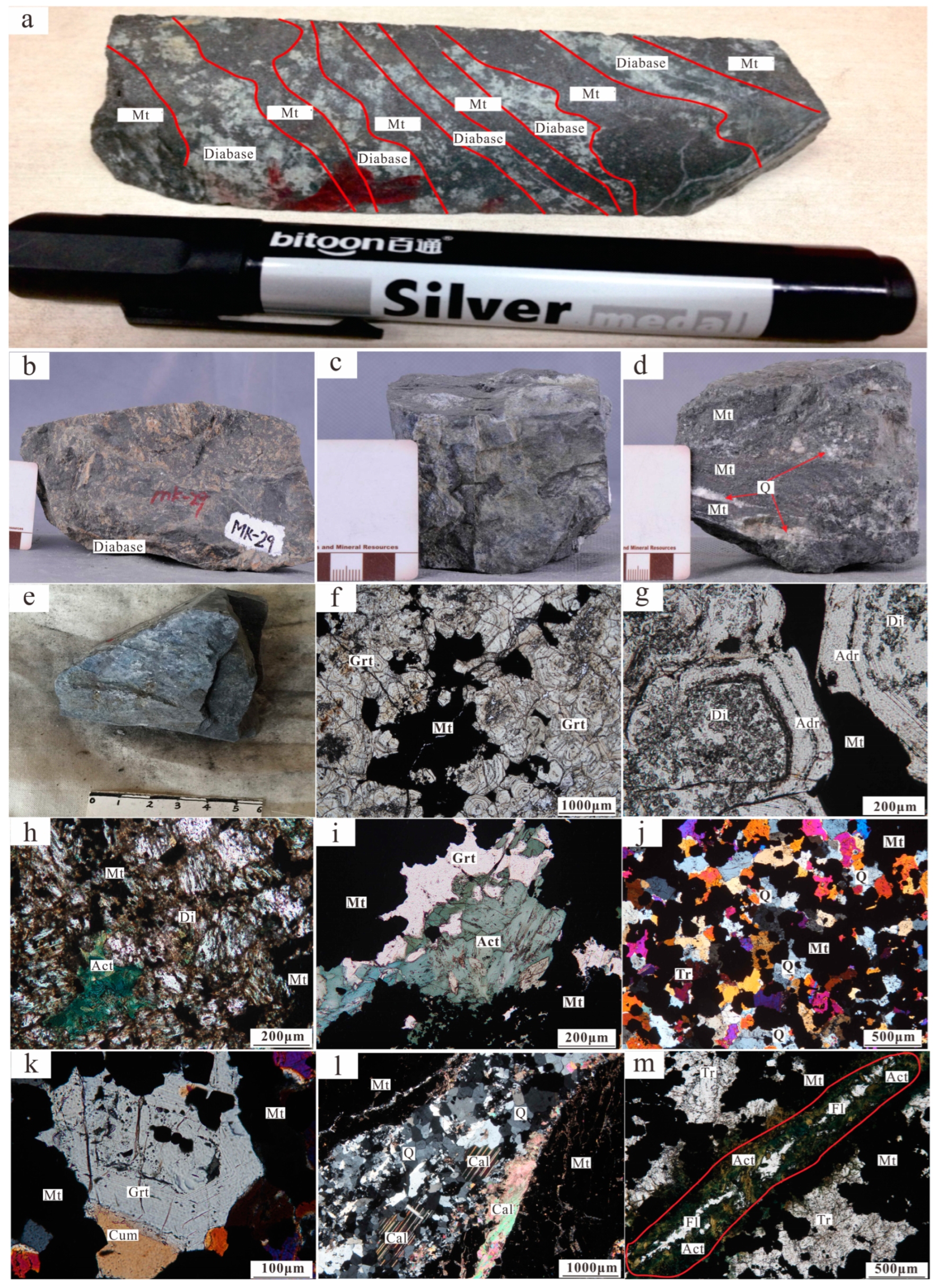
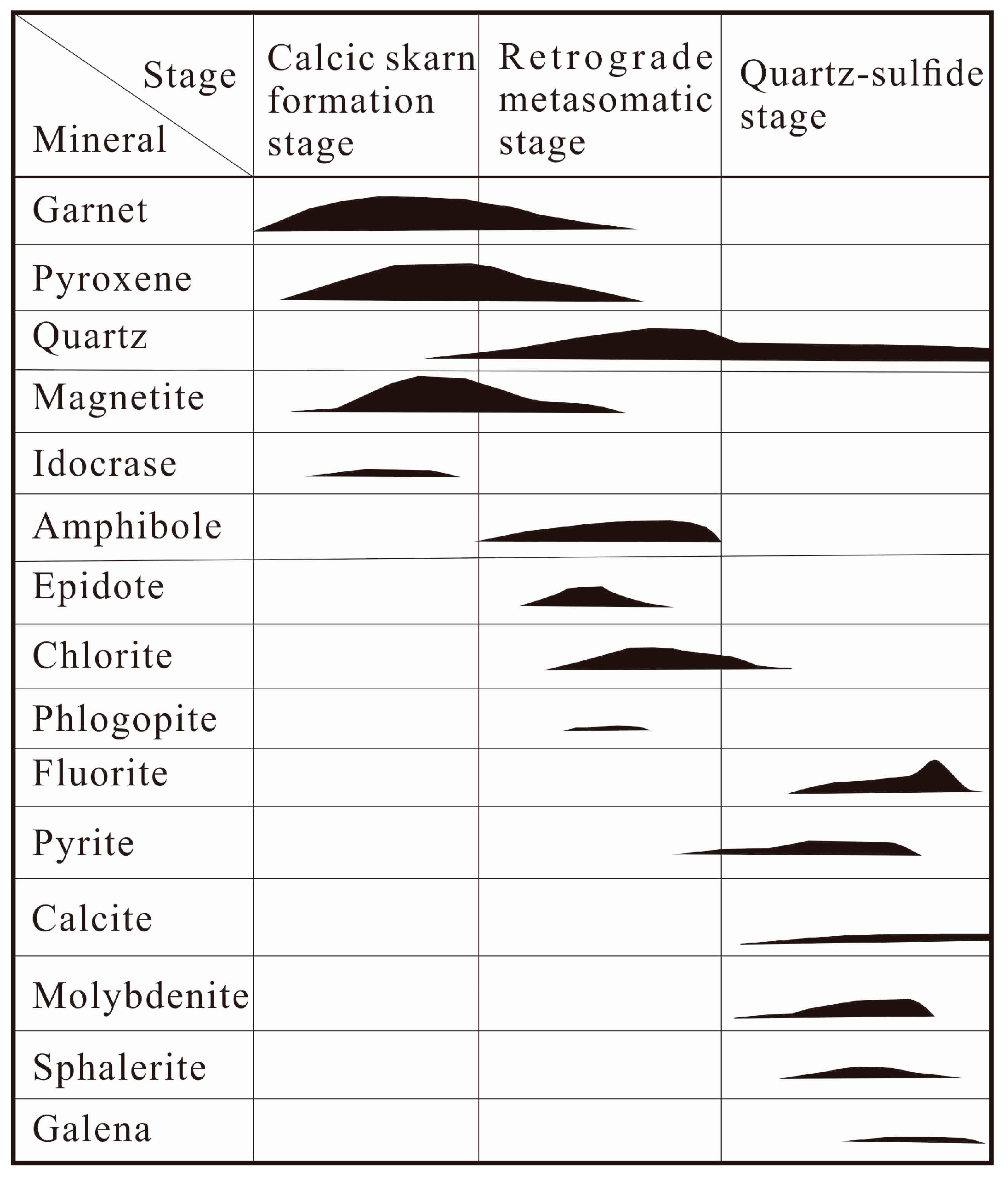
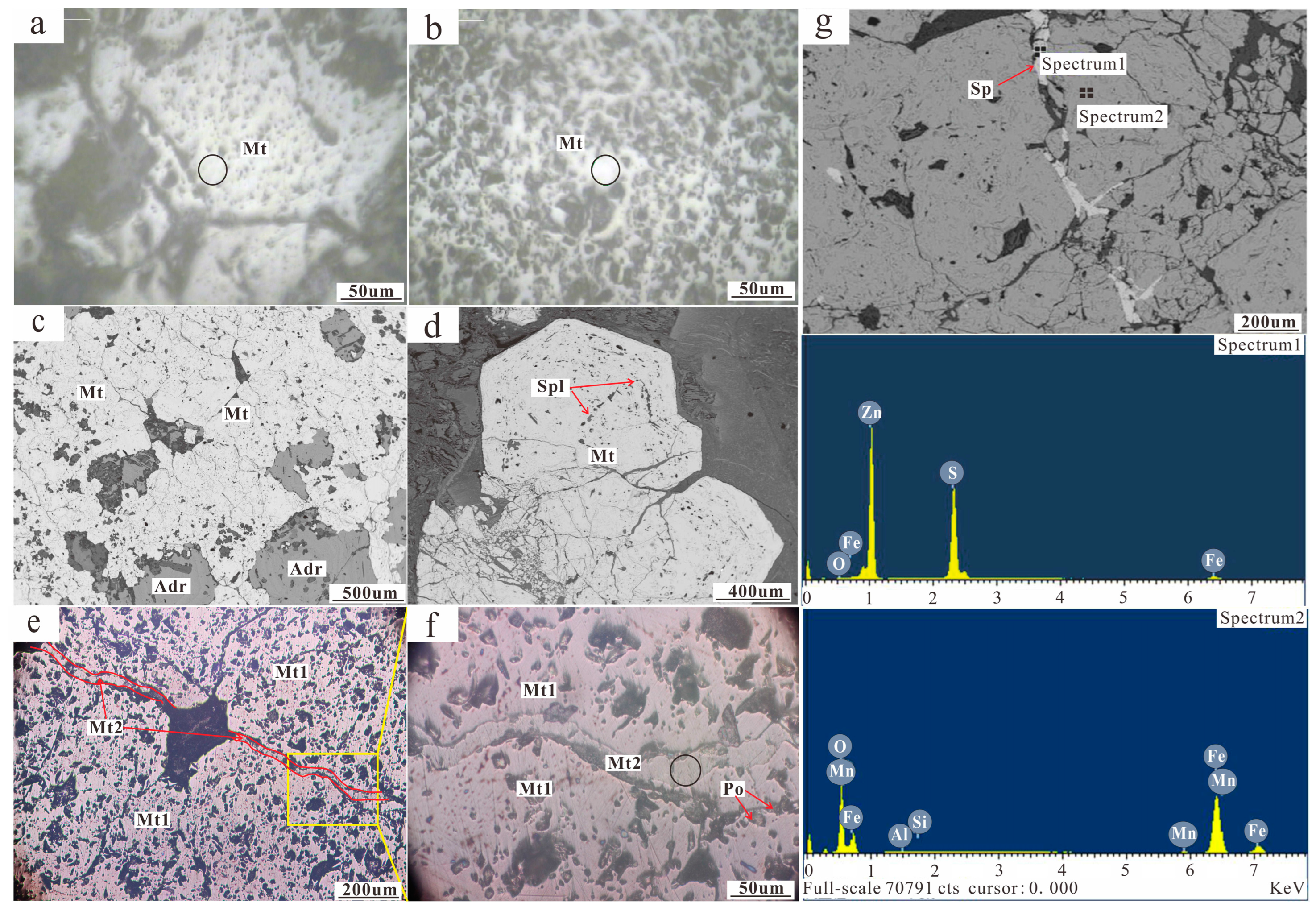



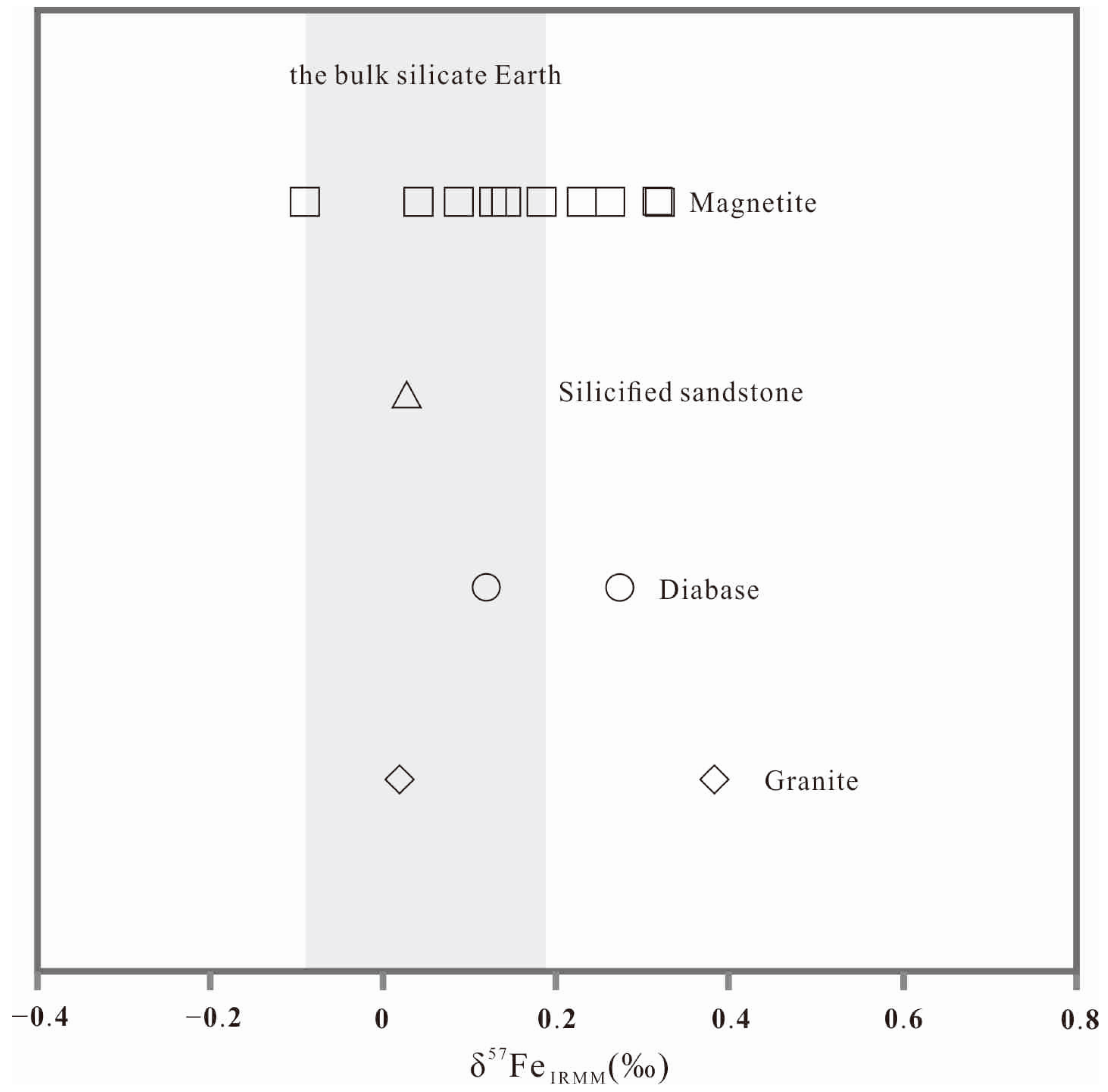


| Sample No. | Sampling Location | Sample Name | Brief Description of Lithology |
|---|---|---|---|
| MK1-2 | 200 horizontal 214# transverse drift | Quartz magnetite | Disseminated structure, with quartz as the main gangue mineral, as well as garnet, diopside, etc. |
| MK1-4-1 | 200 horizontal 214# transverse drift, near the diabase vein | Mineralized diabase | Massive structure, with the actinolite and plagioclase as the main non-metallic minerals, as well as a small amount of diopside and other skarn minerals |
| MK2-2 | 175 horizontal | Amphibole (tremolite) magnetite | Disseminated structure, with tremolite as the main gangue mineral, as well as calcite, quartz, etc. |
| MK2-3 | 175 horizontal | Amphibole (actinolite) magnetite | Disseminated structure, with actinolite as the main gangue mineral, as well as garnet, etc. |
| MK3-2 | 300 horizontal 5# transverse drift | Diopside magnetite | Taxitic structure, with diopside as the main gangue mineral, as well as calcite, quartz, etc. |
| MK3-3 | 300 horizontal 5# transverse drift | Diopside magnetite | Disseminated structure, with diopside as the main gangue mineral, as well as quartz, etc. |
| MK4-1 | 420 horizontal 23# transverse drift | Garnet magnetite | Banded structure, with garnet as the main gangue mineral, as well as quartz, diopside, etc. |
| MK4-3 | 420 horizontal 23# transverse drift | Garnet magnetite | Disseminated structure, with garnet as the main gangue mineral, as well as quartz, fluorite, etc. |
| MK4-4 | 420 horizontal 23# transverse drift | Quartz magnetite | Disseminated structure, with quartz as the main gangue mineral, as well as tremolite, actinolite, etc. |
| MK4-5 | 420 horizontal 23# transverse drift | Amphibole (cummingtonite) magnetite | Dense disseminated structure, with amphibole group mineral such as cummingtonite and byssolite as the main gangue minerals |
| MK4-7 | 420 horizontal 8# transverse drift | Garnet magnetite | Taxitic structure, with garnet and diopside as the main gangue minerals |
| MK4-8 | 420 horizontal 8# transverse drift | Chlorite/epidote magnetite | Disseminated structure, with chlorite and epidote as the main gangue minerals, as well as a small amount of quartz, etc. |
| SN | Sample No. | Sample Name | Sampling Location | Test Type | Results | ||
|---|---|---|---|---|---|---|---|
| δ56Fe | 2se | δ57Fe | |||||
| 1 | ZK9501-14b1 | Granite from Juzhou intrusion | 571.9 m down the ZK9501 borehole | Whole rock | 0.013 | 0.022 | 0.019 |
| 2 | ZK7924-14b1 | Granite from Dayang intrusion | 1001 m down the ZK7924 borehole | Whole rock | 0.260 | 0.022 | 0.383 |
| 3 | Mkjx-b30 | Diabase | 100 horizontal 106# transverse drift underground in mining area | Whole rock | 0.185 | 0.022 | 0.273 |
| 4 | Mkjx-b31 | Mineralized diabase | 100 horizontal 106# transverse drift underground in mining area | Whole rock | 0.081 | 0.022 | 0.119 |
| 5 | Mu-14-2 | Lindi Formation sandstone | 100 horizontal 106# transverse drift underground in mining area | Whole rock | 0.019 | 0.022 | 0.028 |
| 6 | Mu-14-2 | Lindi Formation sandstone | 100 horizontal 106# transverse drift underground in mining area | Magnetite | 0.216 | 0.022 | 0.319 |
| 7 | ZK7922-14b2 | Magnetite ore | 819.1 m down the ZK7922 borehole | Magnetite | 0.215 | 0.022 | 0.317 |
| 8 | 202 transverse drift -14b4 | Magnetite ore | 200 horizontal 202# transverse drift underground in mining area | Magnetite | 0.125 | 0.022 | 0.184 |
| 9 | Mu2 | Magnetite ore | 100 horizontal 106# transverse drift underground in mining area | Magnetite | −0.061 | 0.022 | −0.090 |
| 10 | Mu-13-2 | Magnetite ore | 100 horizontal 106# transverse drift underground in mining area | Magnetite | −0.062 | 0.022 | −0.091 |
| 11 | MKO-2 Mt | Magnetite ore | 200 horizontal 283# transverse drift underground in mining area | Magnetite | 0.086 | 0.022 | 0.127 |
| 12 | MKO-3 Mt | Magnetite ore | 200 horizontal 283# transverse drift underground in mining area | Magnetite | 0.059 | 0.022 | 0.087 |
| 13 | MKO-4 Mt | Magnetite ore | 100 horizontal 106# transverse drift underground in mining area | Magnetite | 0.096 | 0.022 | 0.142 |
| 14 | MKO-6 Mt | Magnetite ore | 100 horizontal 106# transverse drift underground in mining area | Magnetite | 0.178 | 0.022 | 0.263 |
| 15 | MKO-10 Mt | Magnetite ore | 200 horizontal 214# transverse drift underground in mining area | Magnetite | 0.028 | 0.022 | 0.041 |
| 16 | MKO-11 Mt | Magnetite ore | 200 horizontal 200# transverse drift underground in mining area | Magnetite | 0.155 | 0.022 | 0.229 |
Disclaimer/Publisher’s Note: The statements, opinions and data contained in all publications are solely those of the individual author(s) and contributor(s) and not of MDPI and/or the editor(s). MDPI and/or the editor(s) disclaim responsibility for any injury to people or property resulting from any ideas, methods, instructions or products referred to in the content. |
© 2024 by the authors. Licensee MDPI, Basel, Switzerland. This article is an open access article distributed under the terms and conditions of the Creative Commons Attribution (CC BY) license (https://creativecommons.org/licenses/by/4.0/).
Share and Cite
Yi, J.; Shi, X.; Ji, G.; Zhang, L.; Wang, S.; Deng, H. The Geochemical Characteristics of Trace Elements in the Magnetite and Fe Isotope Geochemistry of the Makeng Iron Deposit in Southwest Fujian and Their Significance in Ore Genesis. Minerals 2024, 14, 217. https://doi.org/10.3390/min14030217
Yi J, Shi X, Ji G, Zhang L, Wang S, Deng H. The Geochemical Characteristics of Trace Elements in the Magnetite and Fe Isotope Geochemistry of the Makeng Iron Deposit in Southwest Fujian and Their Significance in Ore Genesis. Minerals. 2024; 14(3):217. https://doi.org/10.3390/min14030217
Chicago/Turabian StyleYi, Jinjun, Xiaoxiao Shi, Genyuan Ji, Lei Zhang, Sen Wang, and Huang Deng. 2024. "The Geochemical Characteristics of Trace Elements in the Magnetite and Fe Isotope Geochemistry of the Makeng Iron Deposit in Southwest Fujian and Their Significance in Ore Genesis" Minerals 14, no. 3: 217. https://doi.org/10.3390/min14030217
APA StyleYi, J., Shi, X., Ji, G., Zhang, L., Wang, S., & Deng, H. (2024). The Geochemical Characteristics of Trace Elements in the Magnetite and Fe Isotope Geochemistry of the Makeng Iron Deposit in Southwest Fujian and Their Significance in Ore Genesis. Minerals, 14(3), 217. https://doi.org/10.3390/min14030217





